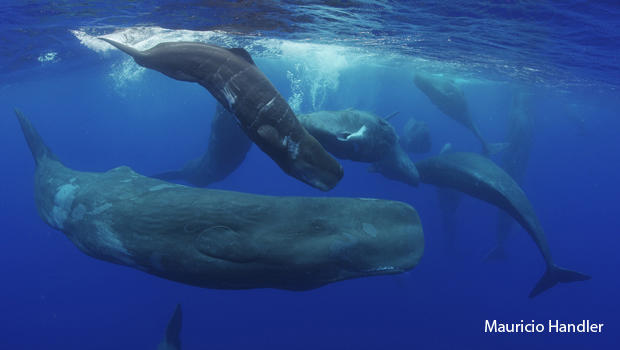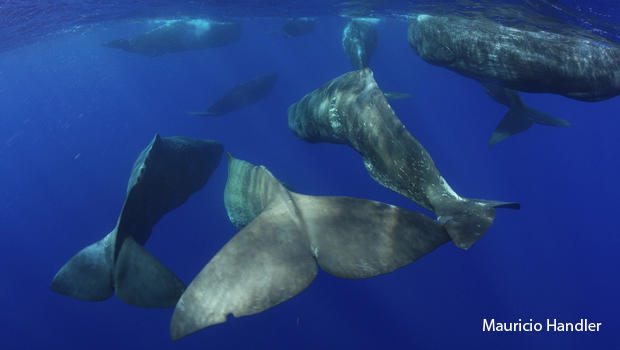Nature up close: Sperm whales
By "Sunday Morning" contributing videographer Judy Lehmberg.
After watching the irony of gigantic animals moving in what can only be considered a delicate water ballet (in a recent Moment in Nature video of sperm whales), I want to go swim with them more than ever. Just think what an amazing experience that must be (assuming one doesn't slap you with their huge tail) to actually be in the water with those huge animals, and maybe even look them in the eye – and be lucky enough to see them look back. What a thrill. Swimming with them is now on my ever-growing must-do list.
Videographer Mauricio Handler recorded these sperm whales in the Azores, a perfect place for them to live as they are surrounded by deep water well-suited to their habit of diving deep for a squid dinner. They are some of the deepest-diving creatures on Earth. The Azores were once one of the more popular places to hunt them, and now that sperm whale hunting is, thankfully, illegal, it is a great place to watch and swim with them.
Sperm whales probably caught our imagination more than most whales because of Herman Melville's "Moby Dick," the famous novel which was inspired by the ramming and sinking of the whale ship Essex by a male sperm whale estimated to be one-fifth the length of the ship.
The largest member of the toothed whales, sperm whales got their name from the mistaken believe their head is full of sperm. It is actually full of spermaceti, a mixture of fats and waxes that was used during whaling days for lamp oil, candles and lubricants. That's not what the whales use it for, however. They use it to make echolocation possible.
The whales generate a series of clicks with a combination of their right nasal passage (which forms a complex labyrinth around the spermaceti) and a pair of "phonic lips" near the front of their head. When they submerge they can pass air through the phonic lips forming clicking noises which are sent through the spermaceti, allowing sound to reverberate and then out into their environment. The emanating clicks bounce off objects in the whale's environment and back again. Once the clicks enter the whale, they are transmitted to an acoustic pad of fat in back of their lower jaw which is then transmitted to their ear bones, allowing them to "see" their surroundings with sound.
They have a collection of adaptations that make that deep-diving possible. Their ribcage is more flexible than in most animals, allowing them to force their lungs to collapse, greatly reducing the amount of nitrogen present and therefore reducing the amount that diffuses into the blood. Nitrogen comes out of solution as an animal ascends, forming bubbles which block normal blood flow, causing "the bendsSperm w" Whales can reduce their metabolism, especially in their digestive system, to conserve oxygen. Their total blood volume is three to four times higher than in a non-diving animal of the same size, and they produce high levels of hemoglobin and myoglobin, both oxygen-carrying molecules. (Hemoglobin carries oxygen in the blood and myoglobin carries oxygen in muscle cells.) The slow release of oxygen from muscle myoglobin aids whales in long, deep dives.
Sperm whales have a relatively small lower jaw with peg-like teeth that cannot chew and only holes in the upper jaw. The teeth are not believed to be necessary for capturing prey, as toothless whales are quite capable of eating.
They are superbly adapted for diving into the ocean depths for their primary food source – squid – although they will take fish as well. It is difficult to know exactly how deep they can dive, but we know they can stay down for 90 minutes and can dive at least 6,000 feet (some sources say as deep as 7,382 feet).
Another aspect of sperm whales that was important to humans is ambergris. As mentioned previously squid are their primary food source. The whale's digestive system is divided into several stomachs. The first is composed of very tough muscle, which acts much like a gizzard to crush food and resist damage from squid beaks. Most squid beaks are regurgitated, but some build up in the second stomach where ambergris is secreted to coat the beaks and protect the whale from damage. In its height of popularity ambergris was extremely valuable, used as a fixative in perfumes, although its use today is uncommon. Today it can be produced synthetically, (although some perfume experts don't believe it has the same desirable properties as the real stuff).
Judy Lehmberg is a former college biology teacher who now shoots nature videos.
See also:
To watch extended "Sunday Morning" Nature videos click here!







